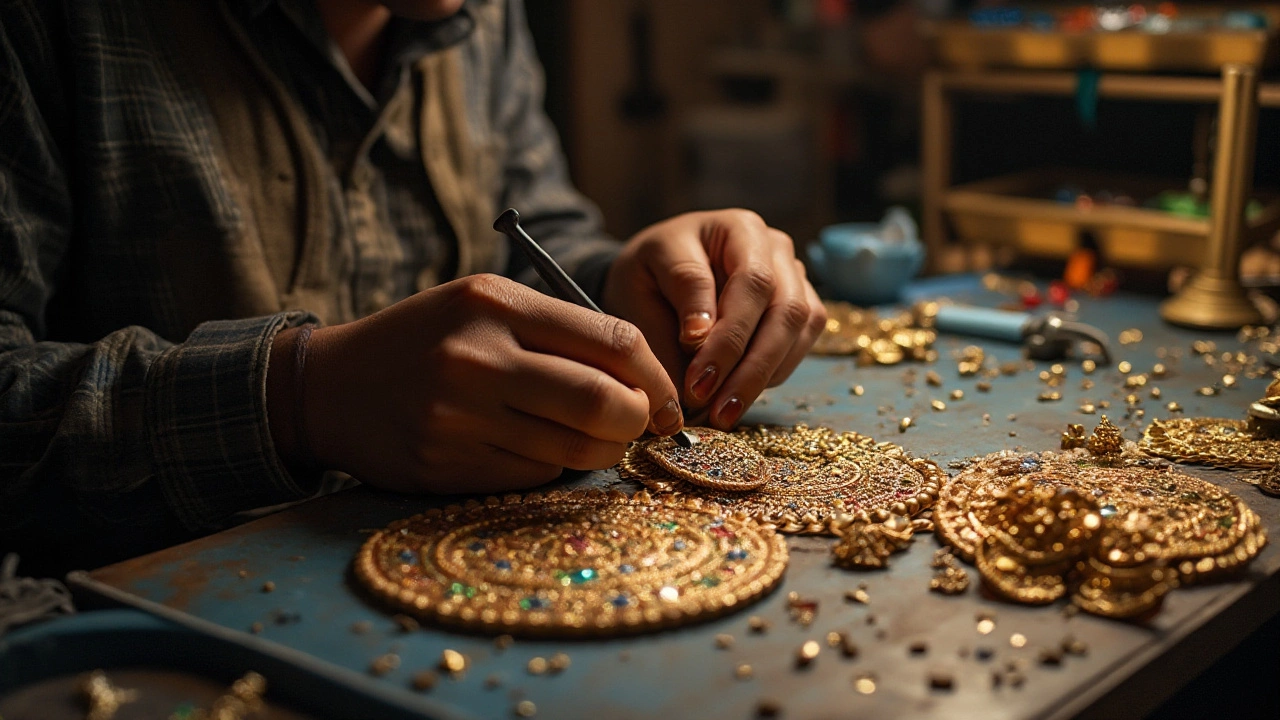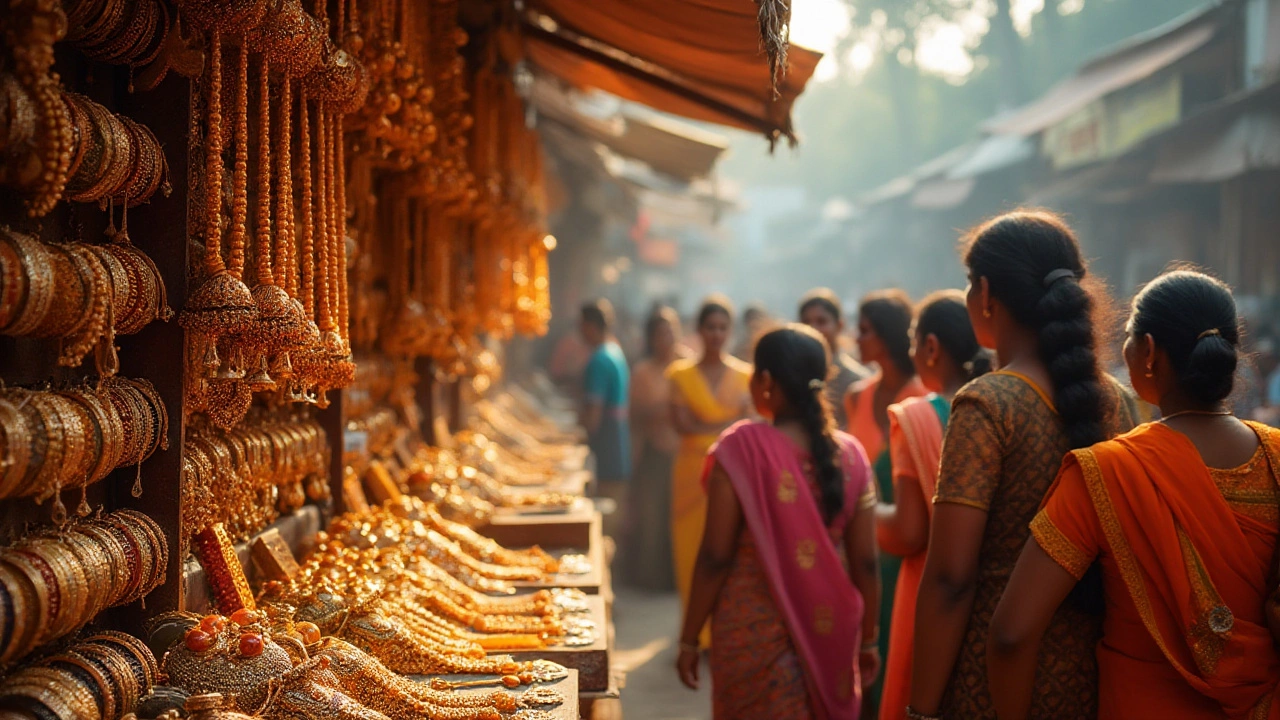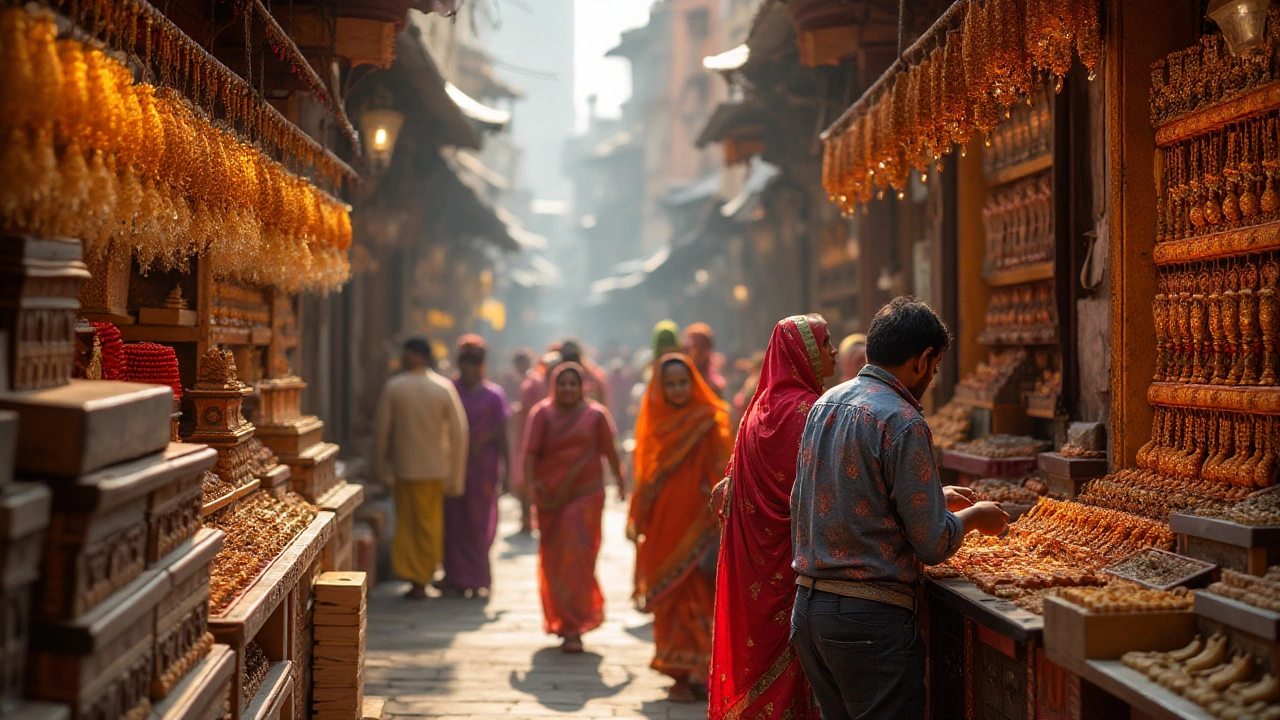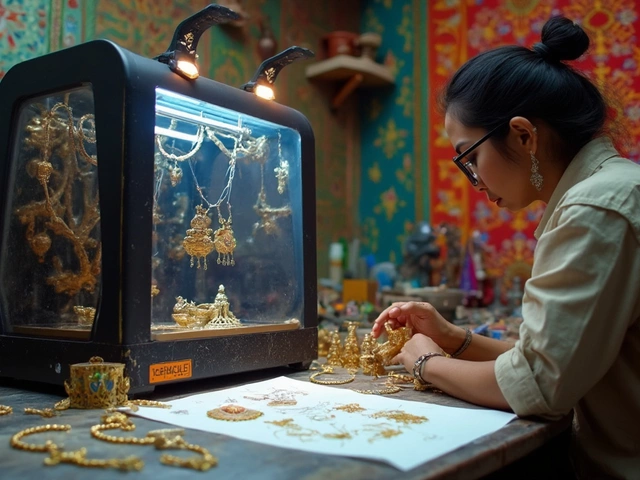Temple jewelry, deeply embedded in Indian tradition, captivates with its intricate designs and cultural significance. As lovers of art and ornaments wander the landscapes of India, they find themselves drawn to cities renowned for their splendid showcases of temple jewelry craftsmanship.
In this exploration, let's unravel the mysteries and charms of the city that stands out among its peers, offering an embodiment of skill, tradition, and artistic brilliance. Dive into the vibrant history and artistry that make Indian temple jewelry a treasure to behold.
- The Art of Temple Jewelry
- Historical Significance
- Cities Renowned for Temple Jewelry
- Exploring the Top City
- Tips for Buying Temple Jewelry
- Maintaining Your Jewelry Collection
The Art of Temple Jewelry
Temple jewelry reflects ancient artistry dating back to the Chola and Pandya dynasties of South India. These jewels originally adorned the idols of deities in temples, anointing them with an aura of celestial beauty. This style of jewelry, a companion of the classical dancers known as Bharatanatyam dancers, is rich with historical significance and intricate designs. Crafted with precision, temple jewelry predominantly uses gold, with designs featuring gods and goddesses intricately carved onto the surface. Even today, the spiritual connotations and cultural value make it a cherished possession among Indian women, worn during weddings and religious ceremonies.
The process of making temple jewelry is arduous, involving skilled craftsmanship passed down through generations. Artisans start by creating molds of wax, which guide the gold carving process. Enhancement of the design's beauty employs precious stones like rubies, emeralds, and pearls. The gemstones are often set using a technique called ‘kundan,’ which involves embedding stones without using prongs or claws. The results are tantalizing creations that boast a level of detail and complexity that few other types of jewelry can match. As such, every piece serves as a testament to the time-honored skills of these gifted artists.
The enduring charm of temple jewelry can be attributed to its elegant blend of tradition with delicately crafted sophistication. Some believe that each piece carries a story—whether it be a narrative of divine legends or tales of historical significance. Notably, the designs often mirror mythical themes, depicting creatures like peacocks or celestial bodies, lending an otherworldly charm to the jewelry's allure. With every exquisite piece possessing its own distinct personality, these works of art become treasures cherished across generations, serving as a bridge between tradition and present-day adornment.
According to Indian craftsmanship expert, Anuja Bhandari, "Temple jewelry embodies not just grandeur, but an ancient spirituality that binds wearer and observer alike."
The artistry involved is striking, with each piece reflecting the cultural essence and divine structures found within the temples themselves.This reverence is evident in the care taken to visually narrate stories — each ornament becoming a timeless chapter among the vast lore of Indian tradition. A confluence of devotion and artistic excellence, temple jewelry’s coveted echo resonates with those who cherish heritage and individuality alike.
Historical Significance
Temple jewelry traces its origin back to the grand and opulent temples of Southern India, where these elaborate pieces first adorned the statues of deities celebrating both the divine and the artisanal skills of an era long gone. This form of jewelry evolved during the Chola Dynasty, over a thousand years ago, serving both a religious and aesthetic function. The intricacies of the designs reflected the artistic flair of the times, with motifs inspired by gods, goddesses, and natural elements, carving a niche in the detailed tapestry of Indian craftsmanship.
Throughout history, temple jewelry was not just a symbol of piety, but also a testament to a patron's wealth and devotion, often crafted using ample amounts of pure gold and adorned with rubies, emeralds, and pearls. The opalescent shine of these stones, especially against the rich gold work, created a divine aura that distinguished these pieces across centuries. These adornments were initially limited to religious ceremonies, where dancers known as Devadasis performed in honor of gods, draped with these glorious creations. This sacred ritual imbued the jewelry with an enduring spiritual aura that remains captivated in temple jewelry pieces today.
As time transported temple jewelry from the inner sanctums of temples to regal courts, it underwent an evolution, gradually becoming a statement of style and tradition in Indian households. Present-day temple jewelry still maintains its essence, melding historical significance with contemporary aesthetics. The same ornate designs can now be seen complementing modern bridal ensembles, having traveled time but never losing its original charm. Indian craftsmanship continues to celebrate this legacy, meticulously preserving the art with each jewel fashioned.
The magnificence of temple jewelry lies not only in its visual spectacle but in its embodiment of centuries-old traditions, as rightly suggested in the words of an anonymous jewelry historian: "These designs are not merely ornamental; they are living chronicles of an era's artistic legacy."
In an era where style often competes with tradition, temple jewelry stands as a delicate bridge between them, holding fast the essence of both historic and contemporary Indian culture. The deep-rooted significance resonates not just in the realm of fashion but also in the broader canvas of cultural identity and heritage. As such, the allure of temple jewelry continues to inspire artisans across India, with cities renowned for their superior craftsmanship leading this cultural renaissance.

Cities Renowned for Temple Jewelry
India, with its rich tapestry of cultural and artistic traditions, showcases temple jewelry as a testament to its ancient heritage. Cities like Chennai, Hyderabad, and Coimbatore stand at the forefront, each offering a unique glimpse into the world of temple jewelry. Chennai, often regarded as the cultural heart of Tamil Nadu, brims with shops and artisans dedicated to crafting intricate designs that speak volumes of the region’s devotion to tradition. The city is a melting pot of cultural events where temple jewelry features prominently, adding an ethereal glow to classical dance performances and temple rituals.
Hyderabad, known for its bustling markets and palatial history, offers a different flavor. Here, temple jewelry is often infused with influences from the city's Mughal and Nizam pasts. The artisans, who have inherited the craft from generations before them, bring a blend of south Indian and royal aesthetics into their work. A visit to Hyderabad's markets, such as Charminar Bazaar, reveals an eclectic mix of temple jewelry adorned with pearls and gemstones unique to the region. The lively exchange of barter and conversation adds an extra shimmer to the experience.
In Coimbatore, the story of temple jewelry unfolds in traditional warmth and community spirit. Known for its textile industry, the city also harbors skilled craftsmen who produce breathtaking jewelry pieces. The Goldsmiths of Coimbatore are renowned for their meticulous attention to detail, producing designs that are sought worldwide. As these jewels often carry intricate iconography depicting deities and mythological stories, they are cherished not only as ornaments but as spiritual tokens. Journeys to these cities are akin to walking through a living museum, where each piece of jewelry has a tale to tell, resonating with the echoes of history.
"The allure of temple jewelry is undeniable. It's not just about the metal and stones; it's a legacy, a blend of devotion and artistry meticulously carved through centuries." - Arundhati Kulkarni, renowned cultural historian.
Each of these cities also hosts vibrant festivals during which temple jewelry plays a crucial role, both in sacred ceremonies and grand celebrations. These events, where dancers and performers don resplendent jewelry, present a kaleidoscope of colors and culture, captivating tourists and locals alike. Enthusiasts who seek not just beauty but also the story behind each piece find joy exploring the bustling streets of Chennai, Hyderabad, and Coimbatore. The narrative of temple jewelry continues, preserved in these cities that embrace tradition while nurturing innovation.
Lastly, the cities' dedication to upholding the craftsmanship is supported by institutions and workshops where new artisans hone their skills. In supporting this age-old craft, these cities not only preserve a rich cultural legacy but continue to inspire and captivate the modern world with their dazzling creations. For those entranced by the charm of Indian craftsmanship and culture, these cities offer a genuine and unforgettable connection to the treasure trove of temple jewelry.
Exploring the Top City
When it comes to the shining world of temple jewelry, the city of Chennai emerges as a dazzling epicenter. Often hailed as the cultural capital of India, Chennai offers a mesmerizing blend of tradition and modernity, making it the perfect backdrop for the flourishing art of temple jewelry. The city has been a hub for centuries, where artisans have passed down their exquisite skills through generations, creating masterpieces that have adorned deities and royalty alike. Walk through its bustling bazaars, and you'll find streets lined with shops that glisten with the radiant glow of gold and precious stones, each piece telling a story of its lush heritage.
Taking a closer look at Chennai's affair with temple jewelry, Kapaleeshwarar Temple is known for its intricate carvings, playing a huge role in inspiring local artisans. While the jewelry was originally crafted to honor the gods and goddesses, it's become a sought-after symbol of South Indian legacy. Indian craftsmanship, characterized by intricate designs of gods, goddesses, and motifs inspired by flora and fauna, is a highlight of Chennai's offerings. As you venture deeper into understanding what makes Chennai the best, witness how the age-old techniques of stone setting and gold plating continue to thrive in the hands of talented artisans.
"Chennai is not just a place; it's an experience of the art form that fuels everyday life here. It's where the past and present merge in the world of tradition and adornment." - A respected jewelry historian.
Besides cultural significance, economics play a critical role. The city boasts of a thriving jewelry market that hosts hundreds of shops and stalls ranging from modest setups to luxurious showrooms. The affinity for temple jewelry in Chennai transcends occasions; whether it's a wedding, festival, or temple offering, Chennai celebrates with the gleam of these unique ornaments. A significant part of the city's charm lies in its craftsmen's ability to customize pieces based on personal preferences while maintaining the traditional essence. It is not uncommon to see customers sitting with artisans to design a bespoke creation that reflects both lineage and personality.
For those planning a visit to delve into the heart of jewelry shopping in Chennai, timing can enhance the experience. The city hosts several jewelry exhibitions throughout the year, drawing both national and international audiences. These are opportunities to not only witness the best of the craft but also to interact with the makers whose hands have shaped these cherished pieces. Alongside, there are numerous workshops open to the public, where one can delve deep into the creation process, from sketching designs to molding metals, offering an all-encompassing glimpse into the artistry of Indian temple jewelry.
Statistics reveal Chennai contributes significantly to India's jewelry exports, with temple jewelry being a notable part of this sector. The demand has grown not only domestically but also among the Indian diaspora, where owning a piece of this timeless craft is akin to possessing a piece of home. For collectors and admirers alike, investing in temple jewelry from Chennai is as much about aesthetics as it is about preserving a tradition that has stood the test of time. This union of tradition, creativity, and economic vibrancy set Chennai apart as the top city to explore exquisite temple jewelry in India.

Tips for Buying Temple Jewelry
When setting out to purchase temple jewelry, it's essential to step into the market with a curious mind and a little bit of preparation. First and foremost, understanding the roots and significance of these pieces can greatly enhance the buying experience. Temple jewelry, traditionally crafted to adorn deities in Indian temples, carries a deeper meaning and is heavily symbolic in its motifs. Therefore, recognizing the symbolic designs such as serpents, lotus, and other motifs can help you appreciate what the piece signifies besides its beauty.
Knowing the materials used is equally important, as temple jewelry is often crafted from precious metals like gold and silver, sometimes adorned with vibrant gemstones. Be prepared to scrutinize the quality of these materials as craftsmanship authenticity plays a vital role. One should always ask for a hallmark certification when purchasing pieces made of pure gold or silver. If gemstones are part of the design, inquire about their origins. Genuine stones can drastically increase a jewelry's value.
Seek the stories behind individual pieces by engaging with artisans or sellers who can offer insights into the creation process. A conversation with a craftsman is often enlightening, offering a peek into the passion and dedication behind the façade of each glittering jewel. In some marketplaces, you might be able to witness the artisans at work. This personal interaction not only enriches your buying experience but also supports the preservation of these ancient arts in their cultural context.
Authenticity and Pricing
Authenticity is paramount. With the popularity of temple jewelry, the market can be rife with replicas. Ensure you purchase from reputable sellers who provide authenticity certificates. Prices can be steep; however, remember that these pieces are not just accessories but heirlooms in waiting, often passed down through generations. Negotiating is generally acceptable in jewelry markets, but having an idea of the price range for temple jewelry can help you gauge worth effectively.
The Federation of Indian Export Organizations notes, "Indian jewelry, such as temple pieces, is not merely about aesthetics but about the legacy and the unmatched craftsmanship."
For those who appreciate temple jewelry for its aesthetic appeal and spiritual significance, an understanding of the patterns and themes can enhance both ownership and collecting experience. Additionally, creating a relationship with trusted sellers can be invaluable when accessing exclusive or custom pieces. Such relationships might even grant insights into emerging trends or special events showcasing unique temple jewelry collections.
Caring for Your Jewelry
Once these ornaments become part of your collection, proper maintenance is crucial. Regular cleaning using appropriate solutions will keep them gleaming without damaging their delicate structures. It's advisable to store such ornate pieces in silk or velvet-lined boxes to prevent scratches and tarnishment.
- Avoid exposure to moisture and perfumes, which can tarnish metals or degrade gemstones.
- Have a specialist inspect your collection annually to ensure all settings remain secure.
- Consider insuring particularly valuable items, safeguarding against loss or damage.
Temple jewelry is a testament to India's rich artistry and heritage. Investing in these pieces is embracing a conversation with history, one you would want to pass on. So choose wisely, purchase responsibly, and care for your collection with the respect it truly deserves.
Maintaining Your Jewelry Collection
Preserving the beauty and integrity of your temple jewelry collection not only ensures its longevity but also keeps the tradition alive through the ages. Given their intricate designs and the unique materials used, temple jewelry requires delicate handling and meticulous attention. Start by storing these pieces in individual fabric-lined compartments. This minimizes contact between pieces, protecting them from scratching or tangling. It's crucial to keep them in a cool, dry environment to prevent tarnishing, especially since the metalwork often involves delicate craftsmanship. Basham suggests using anti-tarnish strips to absorb harmful moisture and slow down the oxidation process.
Regular cleaning is essential yet should be approached with care. One simple method is to gently wipe each piece with a soft cloth after wearing. This removes oils and residues that can dull their shine. For deeper cleans, a mild soap solution and a soft-bristled toothbrush can do wonders; remember to rinse thoroughly to avoid soap residue. Avoid commercial jewelry cleaning solvents, as they might be too harsh. To safeguard gemstones in temple jewelry, be particularly attentive to ultrasonic cleaners that could loosen delicate settings. If in doubt, consulting a professional is advisable to prevent accidental damage.
Understanding the history and components of the temple jewelry you own contributes to proper maintenance. Mannu Reddy, a well-respected Indian jeweler, once remarked,
"Each piece is a story, woven with the memories and craftsmanship of our ancestors."Familiarizing yourself with each type of stone and metal enhances your care routine. Some items might need special considerations; for instance, pearls in temple jewelry should be kept separate from other items to avoid their surface being scratched. Being mindful of cultural practices might enhance your appreciation and care.
Insurance is a vital aspect of preserving your temple jewelry collection. As these items often hold significant value, both monetarily and sentimentally, insuring them can offer peace of mind against theft or accidental loss. Many insurance companies offer policies specifically tailored for high-value jewelry, covering a wide range of scenarios. Having a detailed inventory with photographs, appraisals, and certificates can streamline the process should you ever need to make a claim. Regular review of your insurance policy ensures your temple jewelry is adequately covered over time.



